By Charles Lear
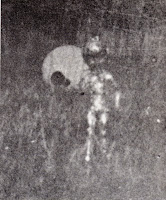 In July of 1967, Ronnie Hill, a 14-year-old North Carolina boy, reported that he’d taken a picture of a UFO with a humanoid in front of it. According to John Keel, who wrote about the story in his article, “The Little Man of North Carolina,” published in the January-February 1969 Flying Saucer Review, the boy sent the picture off to Flying Saucers-UFO Reports, which had just been discontinued by its publisher, Dell Publishing. The editor, Carmena Freeman, sent the picture to Keel and he began a correspondence with Hill, which continued throughout 1968. According to Keel, Hill was “agonizingly slow” in responding to his letters. Keel wrote in his article that he had the photo blown up “to wall size” and that he and “several professional photographers” didn’t see anything that made it seem that the figure was a doll or some other form of hoax.
In July of 1967, Ronnie Hill, a 14-year-old North Carolina boy, reported that he’d taken a picture of a UFO with a humanoid in front of it. According to John Keel, who wrote about the story in his article, “The Little Man of North Carolina,” published in the January-February 1969 Flying Saucer Review, the boy sent the picture off to Flying Saucers-UFO Reports, which had just been discontinued by its publisher, Dell Publishing. The editor, Carmena Freeman, sent the picture to Keel and he began a correspondence with Hill, which continued throughout 1968. According to Keel, Hill was “agonizingly slow” in responding to his letters. Keel wrote in his article that he had the photo blown up “to wall size” and that he and “several professional photographers” didn’t see anything that made it seem that the figure was a doll or some other form of hoax.
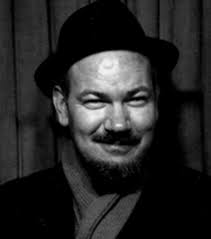
According to Keel, Hill was working in the family garden behind their house on July 21, 1967. Keel then presents the story in Hill’s words. According to Hill, something in the air smelled like gas and caused his eyes to water. He also noticed that it was unusually quiet. He then heard a buzzing sound and the gas smell got stronger. He “caught a glimpse of something moving” that looked like a black hat. He then saw a 9-feet diameter, white ball-shaped object in the air.
Hill said he fell down and then ran into the house to get his camera, described by Keel as a Kodak “Sabie 620.” When he got back, the object was on the ground. A loud noise hurt his ears, and then a humanoid about 3 ½ – 4 feet tall came out from behind the object. It had something in its hand that was shaped like a black funnel. It put it near to the ground and then lifted it up to its hip.
It went back behind the object, there was a loud noise, and a “bright, blue flare bursted from beneath the ‘ship.’” The object rose up “and the big ship reappeared.” The white spherical object connected itself to a rod that pulled it into “a round hole” in the “big ship.” The “big ship” then “took off at tremendous speed.”
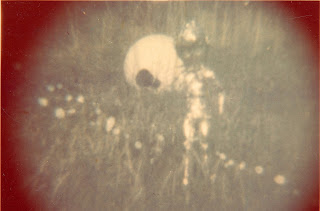 Vincente-Juan Ballester Olmos looked into this case for his UFO FOTOCAT Blog published May 28, 2012. He notes that there is an inset on page 11 of the November-December 1969 Flying Saucer Review with this update: “John Keel, and correspondents of his, have kept a watch on this case and now report that developments have cast doubts on the authenticity of the photograph.” Olmos wrote that that “was the end of it in the literature for years.”
Vincente-Juan Ballester Olmos looked into this case for his UFO FOTOCAT Blog published May 28, 2012. He notes that there is an inset on page 11 of the November-December 1969 Flying Saucer Review with this update: “John Keel, and correspondents of his, have kept a watch on this case and now report that developments have cast doubts on the authenticity of the photograph.” Olmos wrote that that “was the end of it in the literature for years.”
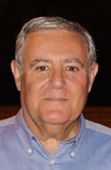
According to Olmos, the picture then showed up on page 230 in a 1980 book by Margaret Sachs, The UFO Encyclopedia with a caption saying that the creature “has been identified as a model with an egg in the background.” Olmos wrote that the quote comes from the “ICUFON (a New York-based UFO organization under the leadership of megalomaniac Colman Von Keviczky.)” Olmos points out that researcher Bob Richards used the quote in an article he wrote and had published in the April-May, 1995 Fortean Times and that James Lewis used it in his 2000 book UFOs and Popular Culture.
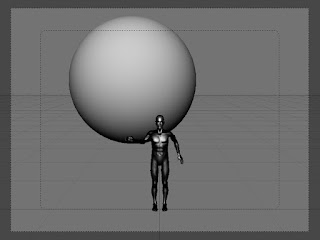 Other researchers also considered the photo to be a hoax, including Luis Ruiz Nóguez, who theorized in his 1996 book, 100 Photos of Extraterrestrials, that the photo was of “a little model and a fake made by ‘the typical precocious US teenager.’”
Other researchers also considered the photo to be a hoax, including Luis Ruiz Nóguez, who theorized in his 1996 book, 100 Photos of Extraterrestrials, that the photo was of “a little model and a fake made by ‘the typical precocious US teenager.’”
Olmos provides a link to a site where the photo is displayed under the heading “ETs, fake.” Under the photo is this caption: “A teenager named Ron Hill claimed to have taken this photo of an ET in his backyard. In reality, the “alien” was a doll wrapped in aluminum foil…”
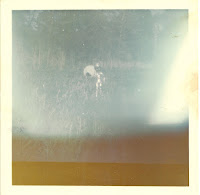 According to Olmos, he contacted Doug Skinner, a friend of John Keel’s who manages Keel’s archives and runs the site johnkeel.com, and Skinner gave him scans of the original polaroid and the two-page letter Hill wrote and sent to Dell Publishing. In the letter, Hill wrote that the time was 2:00 am, which seems to be a mistake because he wrote that it was “a hot sunny day” and that the sun was “right behind” him. Included in his list of details is this: “But strangest of all there wasn’t an animals [sic] around.”
According to Olmos, he contacted Doug Skinner, a friend of John Keel’s who manages Keel’s archives and runs the site johnkeel.com, and Skinner gave him scans of the original polaroid and the two-page letter Hill wrote and sent to Dell Publishing. In the letter, Hill wrote that the time was 2:00 am, which seems to be a mistake because he wrote that it was “a hot sunny day” and that the sun was “right behind” him. Included in his list of details is this: “But strangest of all there wasn’t an animals [sic] around.”
Olmos had a consultant, Andres Duarte, examine the picture and the first discrepancy Duarte found was with the angle of the light. According to him, it should have been 75º at 2:00 pm but was instead 25º in the picture. Duarte also found that the “craft” should have appeared much larger if Hill’s description and estimates of sizes and distances were accurate.